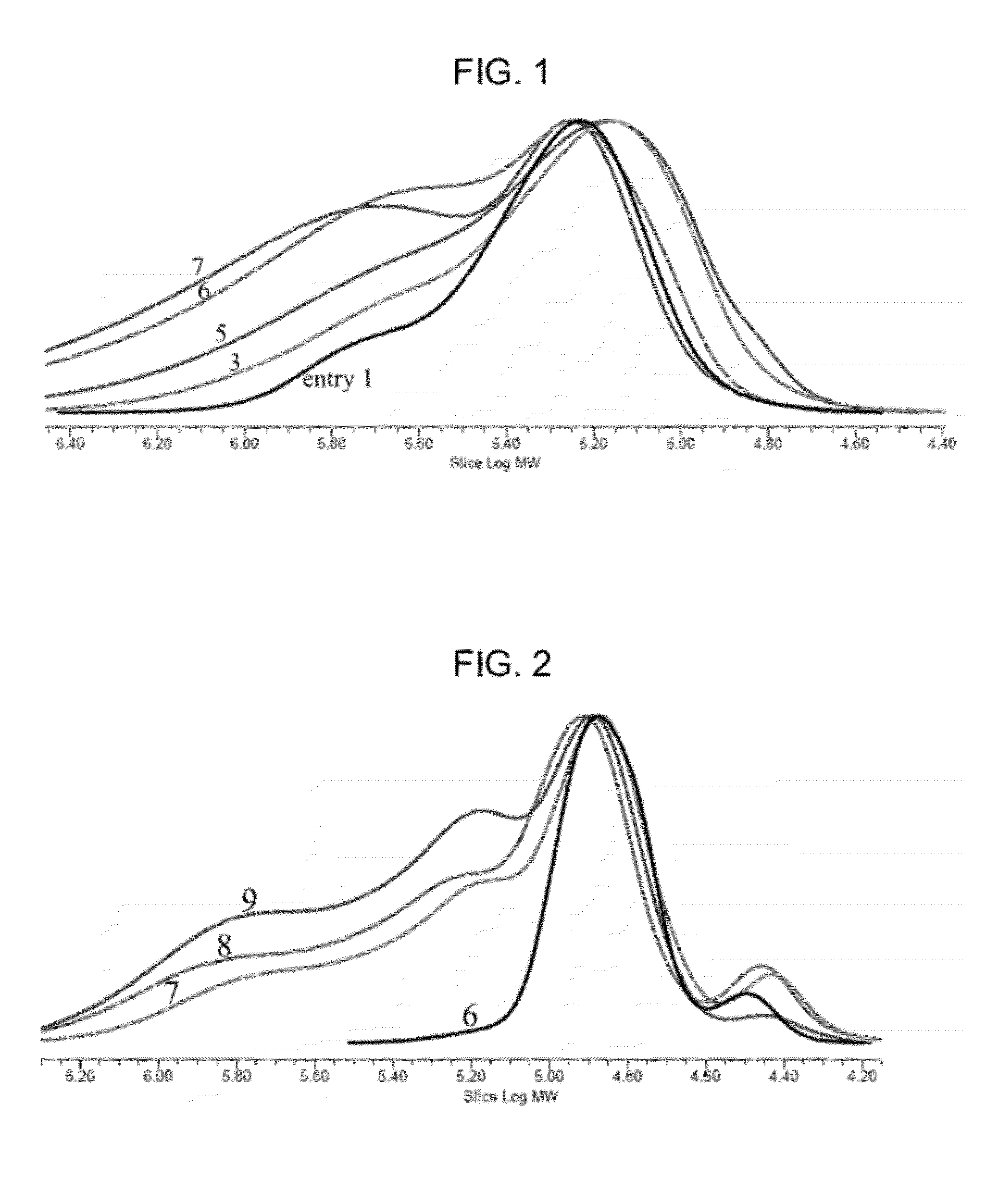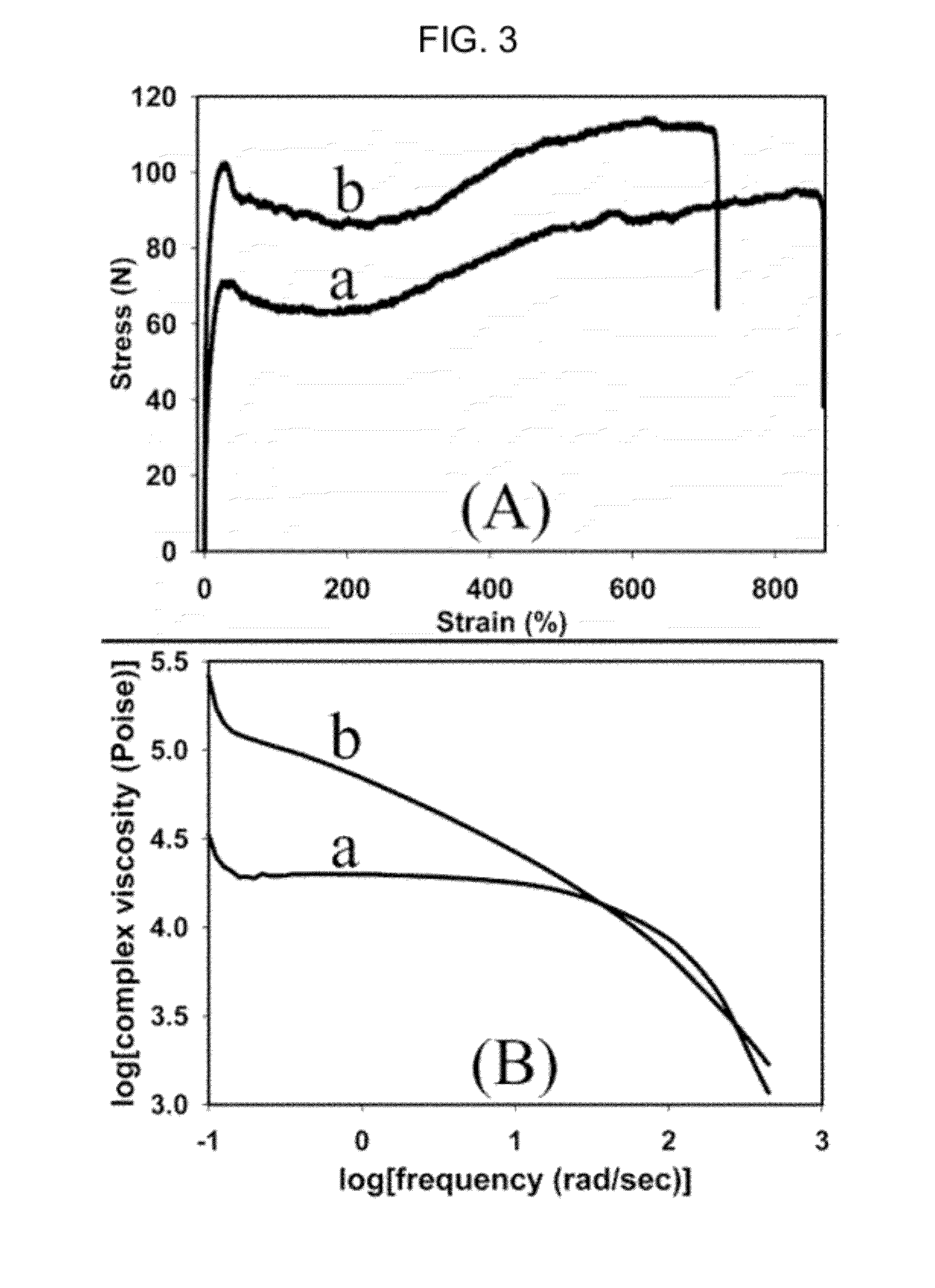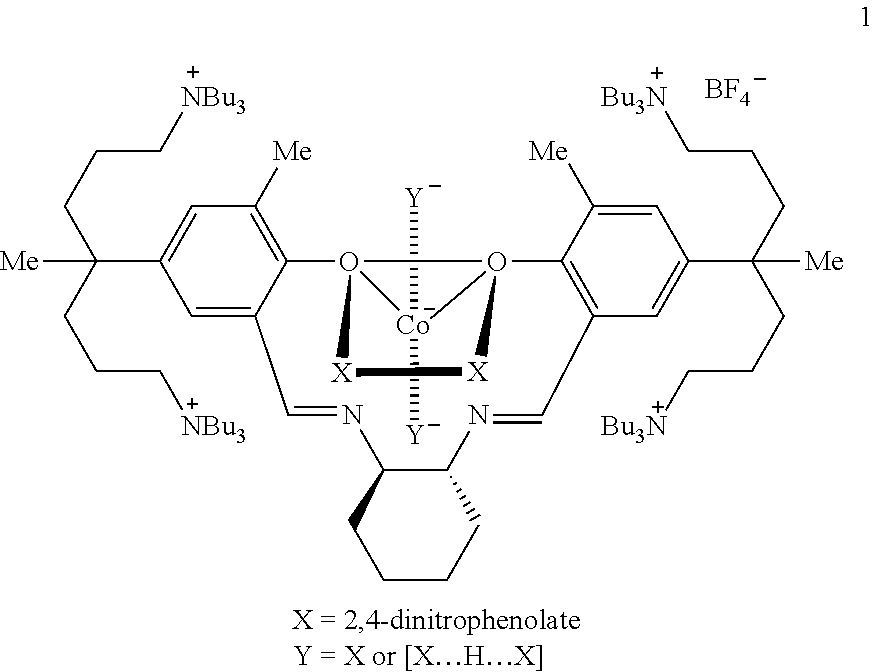Preparation of poly(alkylene carbonate) containing cross-linked high molecular weight chains
a technology of alkylene carbonate and cross-linked chains, which is applied in the field of preparation of poly(alkylene carbonate) and can solve the problems of limitation of poly(alkylene carbonate) itself in the application field, and achieve the effects of high activity, enhanced physical properties and workability of acquired resins, and high molecular weigh
- Summary
- Abstract
- Description
- Claims
- Application Information
AI Technical Summary
Benefits of technology
Problems solved by technology
Method used
Image
Examples
preparation example 1
Synthesis of Catalyst
[0095]The catalyst used in the present invention was prepared as shown below. A compound as a starting material was synthesized according to the known method. (Bull. Korean Chem. Soc. 2009, 30, 745-748).
[0096]Synthesis of Compound B
[0097]The compound A (100 mg, 0.054 mmol) and AgNO3 (37.3 mg, 0.219 mmol) were dissolved in ethanol (3 mL) and stirred overnight. The resultant AgI was removed by filteration over a pad of celite. A solvent was removed by applying vacuum to obtain a yellow compound B as powder (0.80 g, 94%). 1H NMR (CDCl3): δ 3.51 (s, 2H, OH), 8.48 (s, 2H, CH═N), 7.15 (s, 4H, m-H), 3.44 (br, 2H, cyclohexyl-CH), 3.19 (br, 32H, NCH2), 2.24 (s, 6H, CH3), 1.57-1.52 (br, 4H, cyclohexyl-CH2), 1.43-1.26 (br, 74H), 0.90-0.70 (br, 36H, CH3) ppm.
[0098]Synthesis of Compound C
[0099]The compound B (95 mg, 0.061 mmol) and Co(OAc)2 (10.7 mg, 0.061 mmol) were added to a flask and dissolved in methylene chloride (3 mL). After stirring the mixture for 3 hours at room t...
example 1
Copolymerization of Carbon Dioxide / Propylene Oxide in the Presence of Vinylcyclohexene Dioxide
[0102]Compound C prepared in Preparation Example 1 (3.0 mg, monomer / catalyst=100,000) and propylene oxide (10.0 g, 172 mmol) were weighed and introduced into a 50 mL bomb reactor. Then, vinylcyclohexene dioxide
was weighed in a ratio of 10, 20, 30, 40, 50, 60 or 70, respectively, in relation to a molar fraction of catalyst, as listed in TABLE 1, and then, introduced into the reactor, followed by fabrication of the reactor. During reaction, after applying a carbon dioxide gas pressure of 15 bar, the reactor was dipped in an oil bath preliminarily controlled to a temperature of 73° C., followed by starting agitation. After 50 minutes, the reactor temperature reached 73° C. and, at this point in time, it was observed that the reaction pressure started to decrease. From the point in time at which the reactor temperature reached 73° C. and the reaction was initiated, polymerization was executed f...
example 2
Copolymerization of Carbon Dioxide / Propylene Oxide in the Presence of 1,2,7,8-Diepoxyoctane
[0105]Instead of vinylcyclohexene dioxide, 1,2,7,8-diepoxycotane
was weighed in a ratio of 20, 40, 60, 80 or 100, respectively, in relation to a molar fraction of catalyst, and then, introduced into the reactor. Thereafter, polymerization was executed according to the same procedures as described in Example 1. As a catalyst, compound C in Example 1 was replaced by a compound of the Structure 1 described in the Background of Art. TABLE 2 shows results of polymerization.
TABLE 2Results of carbon dioxide / propylene oxide in the presence of1,2,7,8-diepoxyoctane and without the sameEntry[Diepoxide] / [1]TONMw (×10−3)Mw / Mn10150002571.37220125004111.51340140006011.72460130006891.86580120005242.096100Gel——
[0106]Results of the polymerization and data results of GPC analysis demonstrated that the present example shows similar conditions to those acquired by using the catalyst represented by compound C in Pre...
PUM
| Property | Measurement | Unit |
|---|---|---|
| Temperature | aaaaa | aaaaa |
| Temperature | aaaaa | aaaaa |
| Temperature | aaaaa | aaaaa |
Abstract
Description
Claims
Application Information
 Login to View More
Login to View More - R&D
- Intellectual Property
- Life Sciences
- Materials
- Tech Scout
- Unparalleled Data Quality
- Higher Quality Content
- 60% Fewer Hallucinations
Browse by: Latest US Patents, China's latest patents, Technical Efficacy Thesaurus, Application Domain, Technology Topic, Popular Technical Reports.
© 2025 PatSnap. All rights reserved.Legal|Privacy policy|Modern Slavery Act Transparency Statement|Sitemap|About US| Contact US: help@patsnap.com



